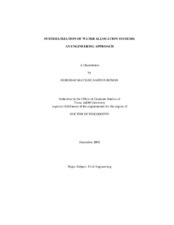| dc.description.abstract | The allocation of water resources is typically accomplished within the framework of
water allocation systems (WAS). In general, a WAS sets priorities, applies rules, and
organizes responses to a range of water allocation scenarios. This research presents a
comprehensive study of water allocation strategies and provides a conceptual framework of
principles and guidelines for designing, assessing, implementing and supporting WAS. The
voluminous compilation of international treaties and conventions, interstate compacts,
intrastate administrative documentation, and scientific/engineering literature was researched
in order to identify different water allocation strategies and mechanisms. From this analysis
eight fundamental areas of WAS were identified: water rights, determination of water
allotment, administrative systems, reservoir storage considerations, system reliability,
multiple uses, instream flow requirements, and drought management. The systematic
scrutiny of these eight areas at the international, interstate, and intrastate levels defined the
conceptual framework for assessing WAS. The Texas experience with regard to its Water
Availability Modeling system is also reviewed with particular emphasis on the application of
the Water Rights Analysis Package (WRAP) model in supporting water allocation efforts.
The Lower Rio Grande WAS was used as a case study to demonstrate how the principles
presented in the conceptual framework can be used to assess water allocation issues and
identify alternative strategies. Three WRAP simulation studies utilizing several components
of the conceptual framework were performed in order to assess the Lower Rio Grande WAS.
The simulations focused on three of the major water allocation issues of the Texas Rio
Grande: reallocation among uses, instream flow requirements, and drought management.
The simulations showed several deficiencies in the Lower Rio Grande WAS, particularly
regarding the size of the domestic-municipal-industrial (DMI) reserve and its effect on the
reliability of other uses. The simulation results suggest that water from the DMI can be liberated to be used by irrigators and to support environmental flows without affecting the
reliability to municipal users. Several strategies were proposed that can potentially improve
the overall efficiency of the system. Nonetheless, implementing new strategies and water
allocation policies in the Lower Rio Grande WAS would require considerable changes in
regulation policies. | en |


